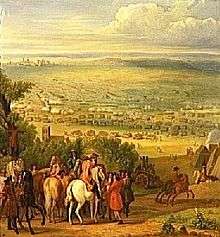Battle of Lens
| Battle of Lens | |||||||
|---|---|---|---|---|---|---|---|
| Part of the Thirty Years' War and the Franco-Spanish War (1635–59) | |||||||
 The Grand Condé at the battle of Lens, 20 August 1648, victory over the Spanish troops commanded by archduke Leopold Galerie des Batailles | |||||||
| |||||||
| Belligerents | |||||||
|
|
| ||||||
| Commanders and leaders | |||||||
| Prince de Condé | Leopold Wilhelm | ||||||
| Strength | |||||||
|
16,000 18 guns |
18,000 38 guns | ||||||
| Casualties and losses | |||||||
| 3,500 dead or wounded |
3,000 dead or wounded 5,000 captured | ||||||

The Battle of Lens (20 August 1648) was a French victory under Louis II de Bourbon, Prince de Condé against the Spanish army under Archduke Leopold in the Thirty Years' War (1618–1648). It was the last major battle of the war. Lens is a fortified city in the historic region of Flanders, today a major city in the Pas-de-Calais region of northern France. The city had been captured by the French in 1647. The nobility rebelled against the leadership of Cardinal Mazarin, known as the Fronde, leading the Spanish to perceive an opportunity to retake Lens and possibly gain ground.
The Prince de Condé rushed from Catalonia to Flanders, and an army was cobbled together from Champagne, Lorraine, and Paris. The French army consisted of 16,000 men (more than half were cavalry) and 18 guns. The Spanish army was larger, comprising 18,000 men (also more than half cavalry) and 38 guns. The armies drew up, but the Spanish were on high ground. Condé decided not to attack. As the French retreated, the Spanish cavalry skirmished with the French rear guard, and the engagement escalated until the armies were fully engaged. The Spanish infantry broke the French Guards regiment, but the superior French cavalry were able to defeat their counterparts and take over the center of the battle.
The year 1648 saw two political developments that were both directly tied to the Battle of Lens, but with opposite results.[3] First, it caused a hardening of the Monarchy's attitude toward the parlements, leading to an initial confrontation in Paris and a protracted struggle that followed.[3] However, the French victory also ended the Thirty Years' War, though not the conflict between France and Spain. The armies of Turenne, Wrangel and Königsmark were threatening Vienna and Prague; Emperor Ferdinand's ally, Maximilian of Bavaria, fervently wanted peace; and Philip IV had lost his main army. Ferdinand had no choice other than to make peace. He approved the propositions for peace from France and Sweden in Munster and Osnabruck. (Since 1641, talks had taken place between France and the Empire in Münster, and between Sweden and the Empire in Osnabrück.) The definitive peace treaty, called the Peace of Westphalia, was signed on 24 October 1648, ending the Thirty Years' War. The war between France and Spain, would not end until the Treaty of the Pyrenees on 7 November 1659).[4]
In the end, the French victory was made irrelevant by subsequent events elsewhere, during the failure to secure Anne of Austria's regency of France while Louis XIV was too young to rule. A civil war in France broke out shortly afterwards, giving Spain the chance of recovery.[5] The Te Deum at Notre-Dame de Paris in honour of the battle ended in a riot, which caused a serious confrontation that led to the revolt. In January 1649, Louis XIV and his ministers had to flee Paris.[6]
Notes
- ↑ Mark Traugott (2010). The Insurgent Barricade. University of California Press. ISBN 978-0-520-26632-2. Retrieved 31 January 2015.
On August 22, Paris learned that French armies under the command of Louis de Bourbon, prince de Condé (known to history as the Grand Condé), had decisively defeated the Spanish army near the town of Lens, in the Pas de Calais
- ↑
- "...the standard of France was white, sprinkled with golden fleur de lis..." (Ripley & Dana 1879, p. 250).
- On the reverse of this plate it says: "Le pavillon royal était véritablement le drapeau national au dix-huitième siecle...Vue du chateau d'arrière d'un vaisseau de guerre de haut rang portant le pavillon royal (blanc, avec les armes de France)" (Vinkhuijzen collection 2011).
- "The oriflamme and the Chape de St Martin were succeeded at the end of the 16th century, when Henry III., the last of the house of Valois, came to the throne, by the white standard powdered with fleurs-de-lis. This in turn gave place to the famous tricolour" (Chisholm 1911, p. 460).
- 1 2 Mark Traugott (2010). The Insurgent Barricade. University of California Press. ISBN 978-0-520-26632-2. Retrieved 31 January 2015.
- ↑ Stephane Thion (19 January 2013). French Armies of the Thirty Years' War. LRT Editions. p. 33. ISBN 978-2-917747-01-8. Retrieved 28 April 2013.
- ↑ Guthrie, William P.: The Later Thirty Years War: From the Battle of Wittstock to the Treaty of Westphalia. Westport: Greenwood Press, 2007. ISBN 9780313324086, p. 181.
- ↑ Parker, Geoffrey: The Army of Flanders and the Spanish Road, 1567-1659: The Logistics of Spanish Victory and Defeat in the Low Countries' Wars. Cambridge: Cambridge University Press, 2004. ISBN 9780521543927, p. 222.
References
 Chisholm, Hugh, ed. (1911). "Flag". Encyclopædia Britannica. 10 (11th ed.). Cambridge University Press. pp. 454–463.
Chisholm, Hugh, ed. (1911). "Flag". Encyclopædia Britannica. 10 (11th ed.). Cambridge University Press. pp. 454–463. Ripley, George; Dana, Charles A., eds. (1879). "Flag". The American Cyclopædia. 8. p. 250.
Ripley, George; Dana, Charles A., eds. (1879). "Flag". The American Cyclopædia. 8. p. 250.
- "The Vinkhuijzen collection of military uniforms: France, 1750-1757". New York Public Library. 25 March 2011 [2004]. Archived from the original on 8 March 2013.